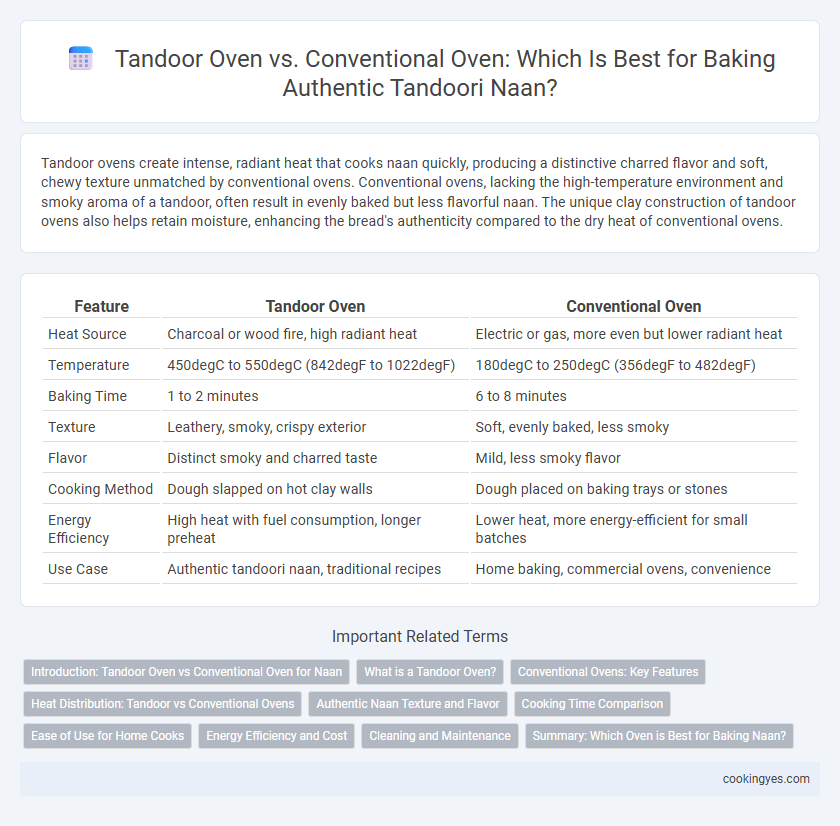Tandoor ovens create intense, radiant heat that cooks naan quickly, producing a distinctive charred flavor and soft, chewy texture unmatched by conventional ovens. Conventional ovens, lacking the high-temperature environment and smoky aroma of a tandoor, often result in evenly baked but less flavorful naan. The unique clay construction of tandoor ovens also helps retain moisture, enhancing the bread's authenticity compared to the dry heat of conventional ovens.
Table of Comparison
| Feature | Tandoor Oven | Conventional Oven |
|---|---|---|
| Heat Source | Charcoal or wood fire, high radiant heat | Electric or gas, more even but lower radiant heat |
| Temperature | 450degC to 550degC (842degF to 1022degF) | 180degC to 250degC (356degF to 482degF) |
| Baking Time | 1 to 2 minutes | 6 to 8 minutes |
| Texture | Leathery, smoky, crispy exterior | Soft, evenly baked, less smoky |
| Flavor | Distinct smoky and charred taste | Mild, less smoky flavor |
| Cooking Method | Dough slapped on hot clay walls | Dough placed on baking trays or stones |
| Energy Efficiency | High heat with fuel consumption, longer preheat | Lower heat, more energy-efficient for small batches |
| Use Case | Authentic tandoori naan, traditional recipes | Home baking, commercial ovens, convenience |
Introduction: Tandoor Oven vs Conventional Oven for Naan
Tandoor ovens, traditionally used in Indian cooking, maintain extremely high temperatures up to 900degF, creating the perfect environment for baking naan with a crispy exterior and soft interior. Conventional ovens typically max out around 500degF, resulting in slower cooking times and less authentic texture. The direct heat and smoky infusion from tandoor ovens significantly enhance the flavor profile and texture of naan compared to conventional baking methods.
What is a Tandoor Oven?
A Tandoor oven is a traditional clay or metal cylindrical oven used in Indian and Middle Eastern cooking, designed to reach extremely high temperatures between 480degC to 500degC (900degF to 930degF). This intense heat, combined with its unique structure, allows naan bread to cook rapidly, developing a distinctive charred, smoky flavor and soft, fluffy texture that conventional ovens struggle to replicate. Conventional ovens, while versatile, typically operate at lower temperatures and provide less direct radiant heat, resulting in naan with a different crust and less authentic taste.
Conventional Ovens: Key Features
Conventional ovens feature consistent heat distribution and adjustable temperature controls, allowing precise baking conditions for naan. Unlike tandoor ovens, they use electric or gas heating elements that provide even cooking surfaces ideal for uniform dough expansion. This controlled environment supports versatility in baking styles while maintaining moisture retention for soft, fluffy naan.
Heat Distribution: Tandoor vs Conventional Ovens
Tandoor ovens provide intense, radiant heat reaching temperatures up to 900degF, creating an even, dry heat that crisply bakes naan with characteristic charred spots and a soft, chewy texture. Conventional ovens typically have lower maximum temperatures around 500degF and rely on circulating hot air, often resulting in uneven heat distribution and a less authentic naan crust. The cylindrical shape and clay walls of the tandoor enhance heat retention and distribution, making it superior for traditional naan baking compared to standard metal convection or electric ovens.
Authentic Naan Texture and Flavor
Tandoor ovens generate intense radiant heat reaching up to 900degF, which creates the signature charred spots and puffiness crucial for authentic naan texture and flavor. Conventional ovens, typically maxing at 500degF, struggle to replicate this high heat environment, resulting in less crispy edges and a softer, less smoky taste. The clay walls of a tandoor evenly distribute heat and impart a subtle earthy aroma that conventional ovens cannot mimic, making tandoor-baked naan distinctly flavorful and traditionally textured.
Cooking Time Comparison
Tandoor ovens cook naan significantly faster than conventional ovens due to their intense, direct heat reaching temperatures between 480degC to 500degC, allowing naan to bake in 60-90 seconds. Conventional ovens, operating at lower temperatures of around 230degC to 260degC, typically require 2 to 5 minutes to bake naan, resulting in longer cooking times and less authentic texture. The tandoor's rapid heat circulation also creates the characteristic char and puff on the naan, which conventional ovens struggle to replicate efficiently.
Ease of Use for Home Cooks
Tandoor ovens reach extremely high temperatures rapidly, enabling authentic naan with perfect char and texture, but require skill and attentiveness to operate safely. Conventional ovens offer controlled temperature settings and easier use, making them more accessible for home cooks seeking convenience and consistency. Although tandoor ovens deliver traditional flavor, conventional ovens provide practicality for everyday naan baking without specialized training.
Energy Efficiency and Cost
A tandoor oven uses concentrated radiant heat and clay walls to efficiently retain high temperatures, resulting in faster naan baking with lower energy consumption compared to conventional ovens. Conventional ovens rely on electric or gas heating elements that require longer preheating and baking times, leading to increased energy use and higher operational costs. The tandoor's design minimizes heat loss and fuel usage, making it a more cost-effective option for authentic naan preparation.
Cleaning and Maintenance
Tandoor ovens, made from clay or metal, require regular cleaning to remove charred residues and ashes, demanding more hands-on maintenance than conventional ovens. Conventional ovens feature self-cleaning functions and smooth stainless steel surfaces, simplifying grime removal and reducing cleaning time. Proper upkeep of a tandoor ensures consistent heat retention essential for authentic naan texture, while conventional ovens offer easier maintenance but may compromise flavor authenticity.
Summary: Which Oven is Best for Baking Naan?
Tandoor ovens provide intense, radiant heat reaching up to 900degF, creating the signature char and soft, chewy texture essential for authentic naan. Conventional ovens typically max out around 500degF and bake naan more slowly, resulting in less crispness and a different flavor profile. For truly traditional naan with optimal texture and flavor, the tandoor oven remains the superior choice.
Tandoor oven vs Conventional oven for baking naan Infographic

 cookingyes.com
cookingyes.com